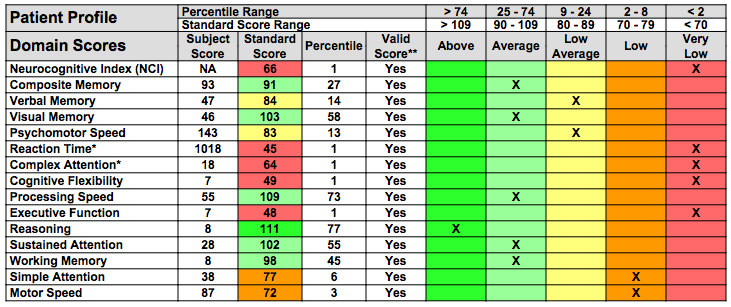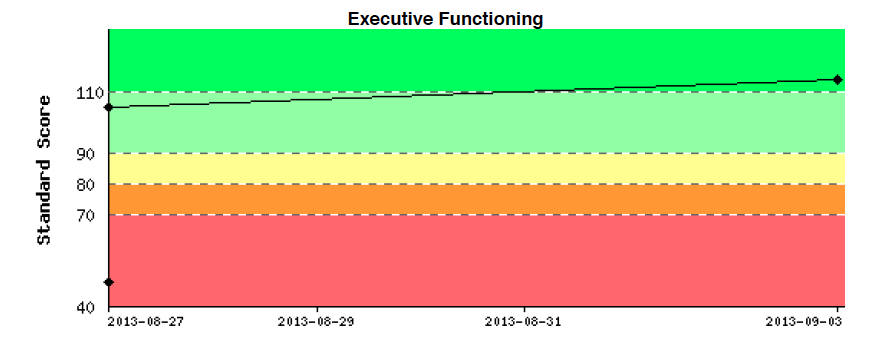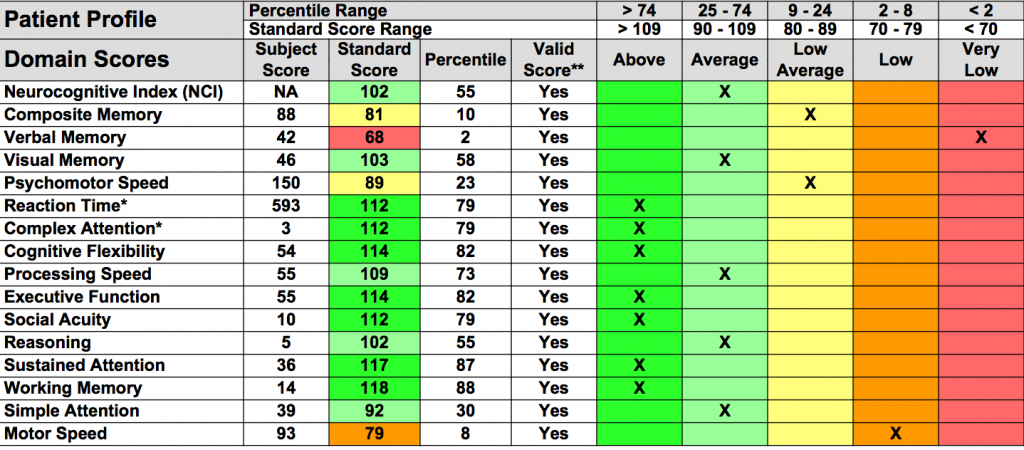Abstract:
Subject reports a series of three head injuries spanning 18 months, from falls and a car accident resulted in progressive compromise in quality of life and disabling disability. Neurological panels before first session, after first session, and after two sessions at day 7, illustrate improvement of brain function. CNS scores improved from 1 to 7 above average scores at seven days after the initial session with two sessions. At day 7 after first session, subject reported restored ability to work, and dream patterns to before the incidents. Subject reported improvements fully persist at 30 months.
Protocol consisted of Whole Body Flush, and 15 minutes of PEMF to the head on day 1, and day 7 for a total of 1 hour total.
Before

Before Concussion Protocol — note 7 extremely low scores. Click on image to view full CNSVS panel.
Two hours later — after protocol.
Click on image to view full CNSVS panel.
This is the patient report on quality of life factors
Therapy Model
The therapy model presumes that residual concussion symptoms like a brain bruise. Regions of the brain remain at low-energy until circulation is restored. The low-energy likely results from capillary inflammation — initially triggered by the injury causing a bruise. Since blood supply is constricted, the oxygen required to reverse the inflammation cannot reach the tissue. This is why concussion symptoms linger for years as inhibited neurological performance.
Therapy consisted of a standard LiveO2-AC protocol, 7 minutes of rich oxygen, followed by about 2 minutes of high altitude, followed by for 30 second high altitude sprints, and then recovery on oxygen. We followed this with about 20 minutes of PEMF therapy to the mid-sides of the head and the back of the head.
The therapy model was to increase pulse pressure and trigger dilation of the vascular system by having her exercise at simulated high altitude for two minutes. Next she switched to a very rich oxygen mixture while her body was adapted to high altitude exertion. The altitude to oxygen switches present a very elevated oxygen burst exploiting respiratory turbulence to increase oxygen saturation in the blood plasma. When this level exceeds 12 cc/L, the anti-inflammatory effect is immediate.
In this case, each of Jill’s 3 concussions damaged regions of the brain responsible for various functions indicated by the neurological tests.
Psycho-motor performance — likely from the back of he head & various cognitive functions corresponding to the mid-sides and top. Her exemplary reasoning skills — remained intact, so she probably never bruised the front part of the brain.
Improved protocol to target brain-blood flow as the BrainO2 protocol.
Day 7 — Patient Report & Re-test neurological panel

The 7‑day neurological test showed last week’s results stuck — and increased slightly.
The second session appeared furthered recovery with apparent “on-switch” of brain function during the follow-up interview.
This test was conducted before a repeat of the training to determine the durability of the first training session.
Note: Verbal memory low score is likely reflects improvement in verbal memory. Memory tests are artificially low when subject is able to remember words from a prior test.
Durability of Results
The natural question is “How long will it last?”. The likely answer is until she gets another concussion. The therapy model was designed to target the brain. In this case, use of 2 minutes of high altitude air, created mild hypoxic stress to trigger vasodilation. Then the sprints to increase respiratory turbulence, and then rapid switches to high oxygen, served to deliver high pressure oxygenated plasma to turn off Ardenne’s vascular inflammation.
The results below show significant improvements in cognitive function. Her video narrative — describing her before therapy mental function significantly diminished is very consistent with the test results. Note how she moved from severely deficient — 1% percentile — to above average in all of the deficient categories.
It seems likely that this functional restoration is likely to substantially restore her pre-concussion mental performance within a few sessions.
3 Year Follow-up
Patient reports results fully persistent. No return of symptoms.




